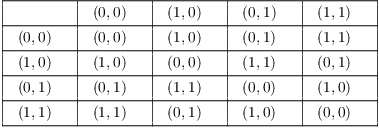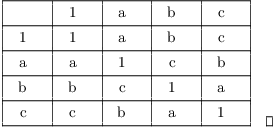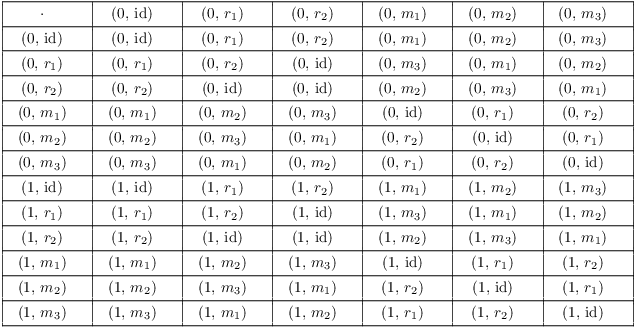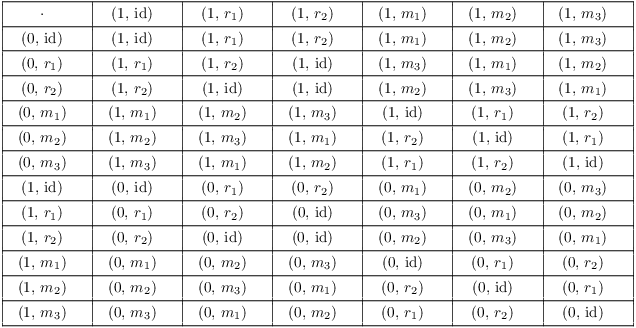Definition. Let G and H be groups. The direct product ![]() of G and H is the set
of all ordered pairs
of G and H is the set
of all ordered pairs ![]() with the
operation
with the
operation
![]()
\overfullrule=0pt
Remarks. 1. In the definition, I've assumed
that G and H are using multiplication notation. In general, the
notation you use in ![]() depends on the notation in the
factors. Examples:
depends on the notation in the
factors. Examples:

2. You can construct products of more than two groups in the same
way. For example, if ![]() ,
, ![]() , and
, and ![]() are groups, then
are groups, then
![]()
Just as with the two-factor product, you multiply elements
componentwise.![]()
Example. ( A product of
cyclic groups which is cyclic) Show that ![]() is cyclic.
is cyclic.
Since ![]() and
and ![]() ,
,
![]()
If you take successive multiples of ![]() , you get
, you get
![]()
Since you can get the whole group by taking multiples of ![]() , it follows that
, it follows that ![]() is actually cyclic of
order 6 --- the same as
is actually cyclic of
order 6 --- the same as ![]() .
.![]()
Example. ( A product of
cyclic groups which is not cyclic) Show that ![]() is not cyclic.
is not cyclic.
Since ![]() ,
,
![]()
Here's the operation table:

Note that this is not the same group as ![]() . Both groups
have 4 elements, but
. Both groups
have 4 elements, but ![]() is cyclic of order 4. In
is cyclic of order 4. In ![]() , all the elements have order 2, so no
element generates the group.
, all the elements have order 2, so no
element generates the group.
![]() is the same as the Klein 4-group V, which has the following operation
table:
is the same as the Klein 4-group V, which has the following operation
table:

If G and H are finite, then ![]() . (This is true for
sets G and H; it has nothing to do with G and H being
groups.) For example,
. (This is true for
sets G and H; it has nothing to do with G and H being
groups.) For example, ![]() .
.
Lemma. The product of abelian groups is
abelian: If G and H are abelian, so is ![]() .
.
Proof. Suppose G and H are abelian. Let ![]() , where
, where ![]() and
and ![]() . I have
. I have

This proves that ![]() is abelian.
is abelian.![]()
Remark. If either G or H is not
abelian, then ![]() is not abelian. Suppose, for instance, that
G is not abelian. This means that there are elements
is not abelian. Suppose, for instance, that
G is not abelian. This means that there are elements ![]() such that
such that
![]()
Then
![]()
Since ![]() , it follows that
, it follows that ![]() , so
, so ![]() is not abelian.
is not abelian.
A similar argument works if H is not abelian.![]()
Example. ( A product of an
abelian and a nonabelian group) Construct the multiplication
table for ![]() . (Recall that
. (Recall that ![]() is
the group of symmetries of an equilateral triangle.) The number of
elements is
is
the group of symmetries of an equilateral triangle.) The number of
elements is
![]()
Here's the multiplication table for ![]() :
:


The operation in ![]() is addition mod 2, while the
operation in
is addition mod 2, while the
operation in ![]() is written using multiplicative notation. When you
multiply two pairs, you add in
is written using multiplicative notation. When you
multiply two pairs, you add in ![]() in the first
component and multiply in
in the first
component and multiply in ![]() in the second
component:
in the second
component:
![]()
The identity is ![]() , since 0 is the identity in
, since 0 is the identity in ![]() , while id is the identity in
, while id is the identity in ![]() .
.
![]() is not abelian, since
is not abelian, since ![]() is
not abelian. A particular example:
is
not abelian. A particular example:
![]()
Example. ( Using products to
construct groups) Use products to construct 3 different abelian
groups of order 8. The groups ![]() ,
, ![]() , and
, and ![]() are abelian, since each is a product of abelian
groups.
are abelian, since each is a product of abelian
groups. ![]() is cyclic of order 8,
is cyclic of order 8, ![]() has an element of order 4 but is not
cyclic, and
has an element of order 4 but is not
cyclic, and ![]() has
only elements of order 2. It follows that these groups are distinct.
has
only elements of order 2. It follows that these groups are distinct.
In fact, there are 5 distinct groups of order 8; the remaining two are nonabelian.
The group ![]() of symmetries of the square is a nonabelian group of
order 8.
of symmetries of the square is a nonabelian group of
order 8.
The fifth (and last) group of order 8 is the group Q of the quaternions.
![]() or Q are not that same as
or Q are not that same as ![]() ,
, ![]() , or
, or ![]() , since
, since ![]() ,
, ![]() , and
, and ![]() are abelian
while
are abelian
while ![]() or Q are not.
or Q are not.
Finally, ![]() is not the same as Q.
is not the same as Q. ![]() has 5 elements of
order 2: The four reflections and rotation through
has 5 elements of
order 2: The four reflections and rotation through ![]() . Q has one element of order 2, namely -1.
. Q has one element of order 2, namely -1.
I've shown that these five groups of order 8 are distinct; it takes
considerably more work to show that these are the only
groups of order 8.![]()
Definition. Let m and n be positive integers.
The least common multiple ![]() of m and n is the smallest positive integer divisible by m and n.
of m and n is the smallest positive integer divisible by m and n.
Remark. Since ![]() is divisible by m and n, the
set of positive multiples of m and n is nonempty. Hence, it has a
smallest element, by well-ordering. It follows that the least common
multiple of two positive integers is always defined. For example,
is divisible by m and n, the
set of positive multiples of m and n is nonempty. Hence, it has a
smallest element, by well-ordering. It follows that the least common
multiple of two positive integers is always defined. For example,
![]() .
.
Lemma. If s is a common multiple of m and n,
then ![]() .
.
Proof. By the Division Algorithm,
![]()
Thus, ![]() . Since
. Since ![]() and
and ![]() , I have
, I have ![]() . Since
. Since ![]() and
and ![]() , I have
, I have ![]() . Therefore, r is a common
multiple of m and n. Since it's also less than the least common
multiple
. Therefore, r is a common
multiple of m and n. Since it's also less than the least common
multiple ![]() , it can't be positive. Therefore,
, it can't be positive. Therefore, ![]() , and
, and ![]() , i.e.
, i.e. ![]() .
.![]()
Remark. The lemma shows that the least common multiple is not just "least" in terms of size. It's also "least" in the sense that it divides every other common multiple.
Theorem. Let m and n be positive integers. Then
![]()
Proof. I'll prove that each side is greater than or equal to the other side.
Note that ![]() and
and ![]() are
integers. Thus,
are
integers. Thus,
![]()
This shows that ![]() is a multiple of m and a multiple
of n. Therefore, it's a common multiple of m and n, so it must be
greater than or equal to the least common multiple. Hence,
is a multiple of m and a multiple
of n. Therefore, it's a common multiple of m and n, so it must be
greater than or equal to the least common multiple. Hence,
![]()
Next, ![]() is a multiple of n, so
is a multiple of n, so ![]() for some s.
Then
for some s.
Then
![]()
(Why is ![]() an integer? Well,
an integer? Well, ![]() is
a common multiple of m and n, so by the previous lemma
is
a common multiple of m and n, so by the previous lemma ![]() .)
.)
Similarly, ![]() is a multiple of m, so
is a multiple of m, so ![]() for some t. Then
for some t. Then
![]()
In other words, ![]() is a common divisor of m and n.
Therefore, it must be less than the greatest common divisor:
is a common divisor of m and n.
Therefore, it must be less than the greatest common divisor:
![]()
The two inequalities I've proved show that ![]() .
.![]()
Example. Verify that ![]() if
if
![]() and
and ![]() .
.
![]() ,
, ![]() , and
, and
![]()
Proposition. The element ![]() has order
has order ![]() in
in ![]() .
.
Proof.
![]()
The first component is 0, since it's divisible by m; the second
component is 0, since it's divisible by n. Hence, ![]() .
.
Next, I must show that ![]() is the smallest positive multiple
of
is the smallest positive multiple
of ![]() which equals the identity. Suppose
which equals the identity. Suppose ![]() , so
, so ![]() . Consider the first
components.
. Consider the first
components. ![]() in
in ![]() means that
means that ![]() ; likewise, the second components show that
; likewise, the second components show that ![]() . Since k is a common multiple of m and n, it must be
greater than or equal to the least common multiple
. Since k is a common multiple of m and n, it must be
greater than or equal to the least common multiple ![]() : that is,
: that is, ![]() . This proves that
. This proves that ![]() is the order of
is the order of ![]() .
.![]()
Example. Find the order of ![]() in
in ![]() . Find the order of
. Find the order of
![]() .
.
The element ![]() has order
has order ![]() .
.
On the other hand, the element ![]() has order
has order ![]() . Since
. Since ![]() has order 30, the group is cyclic; in fact,
has order 30, the group is cyclic; in fact,
![]() .
.![]()
Remark. More generally, consider ![]() , and suppose
, and suppose ![]() has order
has order ![]() in
in ![]() . (The
. (The ![]() 's need not be
cyclic.) Then
's need not be
cyclic.) Then ![]() has order
has order ![]() .
.![]()
Corollary. ![]() is cyclic of order
is cyclic of order ![]() if and only if
if and only if ![]() .
.
Note: In the next proof, "![]() " may mean either the
ordered pair
" may mean either the
ordered pair ![]() or the greatest common
divisor of a and b. You'll have to read carefully and determine
the meaning from the context.
or the greatest common
divisor of a and b. You'll have to read carefully and determine
the meaning from the context.
Proof. If ![]() , then
, then ![]() . Thus, the order of
. Thus, the order of ![]() is
is ![]() . But
. But ![]() has order
has order ![]() ,
so
,
so ![]() generates the group. Hence,
generates the group. Hence, ![]() is cyclic.
is cyclic.
Suppose on the other hand that ![]() . Since
. Since ![]() , it follows that
, it follows that ![]() . Since
. Since ![]() is
a common multiple of m and n and since
is
a common multiple of m and n and since ![]() is the
least common multiple, it follows that
is the
least common multiple, it follows that ![]() .
.
Now consider an element ![]() .
Let p be the order of a in
.
Let p be the order of a in ![]() and let q be
the order of b in
and let q be
the order of b in ![]() .
.
Since ![]() , I may write
, I may write ![]() for some j.
Since
for some j.
Since ![]() , I may write
, I may write ![]() for some k.
Then
for some k.
Then
![]()
Hence, the order of ![]() is less than or equal to
is less than or equal to ![]() . But
. But ![]() , so the order of
, so the order of ![]() is less than (and not equal to)
is less than (and not equal to) ![]() .
.
Since ![]() was an arbitrary element of
was an arbitrary element of ![]() , it follows that no element of
, it follows that no element of ![]() has order
has order ![]() . Therefore,
. Therefore, ![]() can't be cyclic of order
can't be cyclic of order ![]() ,
since a generator would have order
,
since a generator would have order ![]() .
.![]()
Remark. More generally, if ![]() ,
...,
,
..., ![]() are pairwise relatively prime, then
are pairwise relatively prime, then ![]() is cyclic of
order
is cyclic of
order ![]() .
.![]()
Example. ( Orders of elements
in products) Find the order of ![]() .
.
2 has order 2 in ![]() , 4 has order 3 in
, 4 has order 3 in ![]() , and 4 has order 3 in
, and 4 has order 3 in ![]() . Hence, the
order of
. Hence, the
order of ![]() is
is ![]() .
.![]()
Example. ( A product of
cyclic groups which is not cyclic) Prove directly that ![]() is not cyclic of order 8.
is not cyclic of order 8.
If ![]() , then
, then
![]()
Thus, every element of ![]() has order less
than or equal to 4. In particular, there can be no elements of order
8, i.e. no cyclic generators.
has order less
than or equal to 4. In particular, there can be no elements of order
8, i.e. no cyclic generators.![]()
Copyright 2018 by Bruce Ikenaga